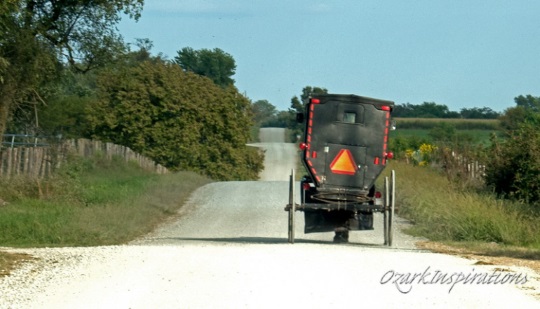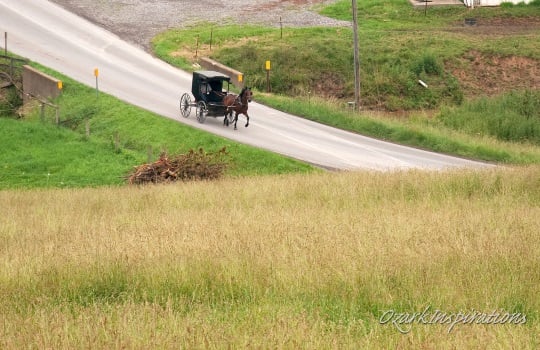All About Amish Church Directories
What is an Amish church directory? Why do Amish publish them? What kind of info do they contain? In the early days of this website, I did a post on the subject, with a look at my 2002 northern Indiana directory.
Don Burke is here to explain further what these guides are, and why you’ll find them in many an Amish home.
At last count I have been to something like 50 Amish communities in about a dozen states, with stays ranging from less than an hour to most of a week. And over the nearly-a-decade that I’ve been doing this I’ve picked up a few tips.

For one thing, I make sure I have plenty of gas in my vehicle, because gas pumps are often not in big demand in horse-and-buggy areas. Another tip is to bring some extra cash, in small bills.
I enjoy stopping to buy – and hopefully visit – at Amish bakeries and other stores, and few of them take debit cards. And when I buy with cash I don’t want to deplete their usually small supply of $1’s and $5’s by paying for a $2.50 loaf of homemade bread with a twenty-dollar bill.
But the biggest tip of all is to first do my research on a community I’m visiting in an Amish Directory.
What is an Amish Directory? An Amish Directory covers all kinds of information for all the settlements in a given region. Many times that region might be a full state.

For less-densely-populated areas the directory can cover several states.

And in more-populated areas the information on just the local community might fill up a book. I recently saw the directory for Adams County, Indiana, and it was as large as the one for the whole state of MO.
The directories are updated and republished semi-regularly. It has seemed to me that they may try to do this like every five years of so.
As I was writing this post I asked a once-Amish friend just what exactly, from the Amish perspective, are the reasons for having the directories. Her response went like this (somewhat paraphrased):
The directories allow the Amish to keep track of everyone. Being related or knowing who is related to who or who married who ultimately allows you to have conversation with most any Amish person you meet. That’s one of the first things they talked about when they discover you have a plain background. If they can find someone that you both know, you instantly have a connection. Also, a lot of older Amish people are into lineage and such, and the directory is a great resource for that kind of information. It helps keep the close-knit-community mindset. It helps you know the latest happenings. You can know who the lady’s first cousin’s son is who had triplets in 1996. <ha> It’s an interesting way for the Amish to connect to each other. Without internet there is no way of keeping track of others, so the “book” is equal to five years of “Facebook updates and statuses.”
To this I would simply add that it can also help the Amish and their drivers find places as they visit others in areas they are not familiar with.
The directory contents are submitted by individuals selected within each local community, then all of these are compiled by an editor or publisher. Entries for the various locations do not always have the same content, but typically include some or all of the following:
-
- The origin and/or updates of the community history. These entries may show connections with other settlements that the group originally came from, and occasionally include some of the personal hardships and struggles experienced within the community.
- A listing of all the men, past and present, who have served as ministers in the community.

- A map of the whole community (often hand drawn or traced).
- Similar maps of the individual church districts within the community, with markings where each family lives, and possibly where schools and cemeteries are located.
- A listing of each family in the district, with full names and birthdays of each member of the family. The listing also gives the parents of both the father and mother. Occupations are also usually given.
- Sometimes there is also a map and/or listing of businesses, either on the community or individual church district level.
- Various indexes in the back may include listings of all heads of households in the whole book, list of wives, seniors, widows & widowers, etc.
With a community’s map(s) I can quickly see where to find most of the Amish homes in that settlement. I can tell far more about a community in 20 minutes of driving around looking at their buggies and their homes than I likely could find out in far more time spent talking to someone.
For example, a settlement’s degree of conservatism is often readily visible in just seeing how homes are constructed and maintained, the routine items around the homes, or from taking quick pictures of three of four buggies to be more closely examined later.

For me one of the most interesting parts of visiting a community is to see how it is different from others I’ve been to. In one settlement I noticed that many of the Amish homes and a school used three-tab shingles as a form of siding on the exterior walls.

And you can imagine the great surprise when I discovered (on two different occasions) an Amish group which drove tractors instead of horse-and-buggies for their day-to-day traveling.


Or the group on the other end of the conservative-spectrum which refused slow-moving-vehicle orange triangles and electric flashers on their buggies and wagons, but instead used kerosene lanterns to (hopefully) be visible to traffic at night.


An Amish Directory can also let you discover Amish communities that you didn’t know about. Just a quick scan through the table of contents and you can find where the various settlements are in the area.
I’m a sucker for Amish baked goods, and as I’ve noted before I think they should be the foundational (read: largest) layer in a revised food pyramid. <ha> If the community’s directory entry has a listing or map of businesses you can bet that I’m scanning for fresh goodies! And if there is no business map/listing, a quick scan through the families’ occupations might still find me the precious morsels I so enjoy.

Yet another benefit a would-be visitor can glean from the Directory is identifying businesses where you can shop and possibly strike up a conversation with someone from the community (such as the shop owner).
Naturally many businesses are geared more to Amish needs (e.g., a tack shop), and the people working there might be less used to just visiting with a non-Amish who drop in (however, I once enjoyed a particularly long conversation with an older Amish gentleman at his tack shop). But some businesses, like a bakery, nursery, vegetable stand, and even some bulk food stores might be more used to non-Amish customers.
And a quick side note here: Remember that while we might just be out enjoying a day off, the Amish person likely isn’t. If you take up their time visiting with them at their shop, consider showing your appreciation by buying something you can afford and use. Or at least show some genuine interest and appreciation for his or her work. I’ve found myself in a couple of woodworkers’ shops, and to have someone show an interest in their handiwork seemed to mean the world to them. In short, be sure to try to give as well as receive.

So, where can you get an Amish Directory? If you only have a rare need for information on a single location, as strange as this might sound, you might find some help with a quick online search. Communities which are a bit more visitor-friendly sometimes have maps or business listings online (simply do a web or an image search using “Amish,” “map” and the community’s location as keywords.)
But to get an actual Amish directory your best option is to find a store in an Amish community within the region and see if they have one for sale. Sometimes a store in one community might even have directories of other regions. The Adams County (Indiana) Directory I mentioned earlier I found in an Amish store in Missouri, because many of those who originally settled in the Missouri community had moved there from Adams County, and still have connections back in Indiana.

And don’t be surprised if the directories are not cheap. I would expect to pay at least $20-30 for one, and maybe more. But for those who even semi-regularly venture out into new territory, it will be an investment well spent.
So, let’s see….
- Jeep gassed up – check
- $20 in singles – check
- Camera batteries charged – check
- Amish Directory packed and within arm’s reach – check
…Looks like I’m all ready for my next visit.
Publisher Credit
- Central Plains Amish Directory published by Enos & Freda Yoder, Inola, OK, 2012
- Missouri Amish Directory compiled by Lester Yoder, Windsor ,MO; printed by Pilgrim Book Printing, Medina, NY, 2016.






Connections among Amish
The statement about being “connected” with the Amish is so true, even for us non-Amish. We are from Ohio, and have been very friendly with some Holmes County Amish. We are also very friendly with some Lancaster County, PA, Amish. When either group discovered our “connection” with the other, there was an immediate sense of belonging, if I can call it that. Then, as we met other Amish, and they learned of our connections, it continued. We have made many Amish friends we would have not otherwise met without our original Amish connections.
Connections....
Richard, I have seen some of the same thing related to connections. This was especially true when my wife and I visited in the Berne, IN area. It seemed that whenever one of the Amish found out we lived in MO, they would ask if we had connections to the Seymour settlement — which was first settled by some of the folks there in Berne.
Great point Richard. Have seen it many times. This feeling of an extended “family” that stretches across communities and beyond state borders is one of the things I’ve really appreciated while spending time among Amish.
Amish Directories
The directories are a gold mine of information for folks who for whatever reason need to learn about a community they have not been to before. I used various directories when I did some advocacy work for Amish communities in Minnesota and Wisconsin years ago.
Good point Lee, I find them fascinating, ranging from the colossal Holmes County directory to the thin ones of just a few sheets you might find in a smaller settlement.
By the way, your name caught my eye – if you don’t mind me asking, would you be the Lee Zook whose name I’ve seen published in The Amish and the State and other places?
That would be me.
Ah, nice to know that, welcome. I really appreciated your chapter in that book. Also I noticed you’re associated with Luther College, I lived in Decorah one summer, 20 years ago. Wonderful town.
A question for Lee Zook.
I live in Maine and on a recent road trip I bought items at a couple of Amish Farms along the way. One was a basket and the crafter’s name on the bottom of it was Zook. Do you have relatives in Maine? Just curious.
Zook is an incredibly common name among the Amish.
where to find directories
I was able to purchase several directories on ebay very cheaply. If you set up and automatic search/notification of when they are available, then you can obtain one whenever one is posted for sale.
After I was done with my research I was able to resell them via on Die Botschaft via a free classified ad. I guess you might also be able to put in a free ad too to obtain an old one.
If you want to buy a new one for Lancaster you could order one from Gordonville Book Store 275 Old Leacock Road Gordonville, PA 17529
717 768 3512
Gordonville Book Store
We really enjoyed visiting that bookstore last fall. LOTs of interesting books, and all kinds of stuff for homeschooling.
The owner, turned out to be a childhood friend, of an Amish friend of ours, whom we had visited!
It was interesting to us, that the two men had been friends for many years,though lived MILES apart.
Then, when we visited an “in Home Amish Quilt store” the owner there in Ronks, did not know either of those two men, all about the same ages. My small knowledge of Amish, thought that a lot of Lancaster area Amish, would know most of the others! lol
It seems that a lot of the Amish who we met, were a lot like us “Englishers” who don’t know everyone of our religion, in our own areas! lol
Dove at the Window
My mother, Gertrude Huntington, said she saw on Research Gate that you would like a pdf of her dissertation on the Amish. She does not have your contact info, however.
I enjoyed reading about Amish Directories and the ways they are helpful in your travels and other contacts with Amish settlements, Erik.
I have appreciated using the Elkhart/Lagrange (Ind.) Settlement Directory when I serve as a volunteer tour guide every spring at Menno-Hof Amish-Mennonite Information Center in Shipshewana, Ind. Some examples:
A visitor from Australia was very interested in different ways Amish in the area are employed. The Elkhart/Lagrange Settlement Directory has a very good section on employment, listing dozens of occoupations and how many Amish people who are head of households are employed in each occupation. A non-Amish visitor had a great grandfather who was an Amish minister in the settlement and he wanted to learn a little more about him. So, we turned to the settlement directory’s section on Amish ministry and found the year he was ordained and the church district where he was ordained. Another visitor had lived in the Elkart/Lagrange area for many years, but moved to another state twenty years ago. He wanted to learn more about how large the settlement had become. So, we enjoyed looking at the maps in the directory and he was surprised to see how far the boundaries of the settlement now stretched and how close the southwestern boundary was now to the Nappanee settlement boundary. The directory also has a good section on Amish history, both on the origins of the Amish faith in Europe in the 16th century and the history of the Amish in that settlement.
I was wondering, Erik, if you know if the larger more conservative settlements also have settlement directories (such as Swartzentruber settlements in Ethridge, Tn., or Wayne, Co. Ohio).
I just returned from there
My family and I just returned from a WONDERFUL visit to Shipshewana, Ind. Behind the ice cream store Dips, is a local clothing and textile store definitely NOT for tourists, but for the real Amish to procure clothing and daily needs including prayer books and bibles.
I leafed through a couple volumes of these Amish Directories. I found them fascinating, but this was not a library and I thought it wrong ar at least inconsiderate to use their books without buying. I was about to buy at least one of those incredibly detailed and fascinating sociology exposes, but I really thought a local family would need that for more necessity than my simple curiosity.
Now, I see I should have bought both!
Amish Directory
Don
Well don on the Amish Directory. Really liked the picture of H&M Country Store. As you know that is only about 2 miles from the home of one of my Amish nephews that live in that area. One of my great nieces works there part time since she got married last fall. We had the opportunity and priviledge of attending the wedding. As I have said before Don you do great work in explaining many of the things about the Amish. I grew up in that faith my first 18 years of my life. But left to strike out on my own. Been blessed to have my 80th birthday last month and am really blessed with good health. Blessings to you
Andy, congrats on reaching the status of octogenarian (80 years old)!! Happy belated b’day.
Yes, I recall your nephews being close by, but wasn’t aware that one of their daughters works at H&M. (A great store, btw.) Sometime you’ll have to let me know who your grandniece is because I may know her — H&M is a regular stop of mine when I’m in Jamesport.
Thank you for the compliments.
Blessings to you as well, my friend.
I apologize to you, Don. When I made my comments, I wrote it such that I thought Erik had written all the good information about Amish directories.
After Andy’s comments above, I re-read the posting and realize I overlooked the line Erik included at the beginning of the post stating that you had written the information. So — to restate my comments — it was interesting reading how you use the Amish directories in your travels and other contacst with Amish settlements.
My question remains the same (either for you or Erik) — Do the most conservative Amish affiliations such as Swartzentruber communities publish directories? Or are they maybe included in an area directory with several Amish affiliations — such as Holmes and Wayne Counties have several groups, so is there a directory for that area that includes members of more than one affiliation?
No Harm, No Foul....
Al…, not a problem. I just took it as you writing to Erik as the Commander and Chief of the space here, and he does deserve no small share of the credit for making what I submit presentable for public viewing anyway. {ha} So all is good.
As to your remaining question, I’m afraid that I don’t have a clue. Sorry I couldn’t be of some help.
Swartzentruber Amish directories
Comment on comment, I’ve seen Swartzentruber Amish listed in Minnesota Directories. The newer settlements may make use of them while Holmnes County appears not to.
Good to know that. Maybe it’s certain of the Swartzentruber sub-groups that do that. Or maybe just random communities?
Thanks, Lee and Erik, for your replies regarding Swartzentruber listings in Amish directories.
I’m wondering if some of the reasons why some settlements don’t have directories of their own is because of the all the time involved in gathering all the statistics and then the cost in the production/printing of the actual directories.
Swartzentruber Amish not in directories
Good question Al, and glad Don got the credit here 🙂 To my knowledge the Swartzentruber Amish do not participate in directories. They’re not included in the Holmes County directory, for example. However, they do show up in Raber’s Almanac church listings, as you probably know.
builder in Milwaukee, WI
Are there any Amish builders that want to build a garage in Milwaukee, WI?
I'm looking for An Amish couple whom I stayed with as a child.If I'm not mistaken,Their names are Nelson & Joyce Weaver. I was raised an a mennonite and spent a couple if summers with them...I have been searching for them for many of years
Can you help me with this?
Nelson & Joyce Weaver
They lived in Lancaster, Pa …Reverend Espenshade was our Pastor during the 80’s
Directory
Hello I’m a upper New York driver for the Amish in Franklin, St. Lawrence and Jefferson counties. I would like to know where I can purchase directory for my area. So I can get to the family in a manually time. Please and thank you